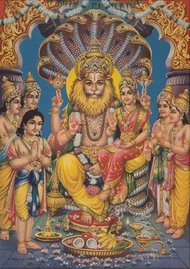Samputa Narasimha:For Vaisnavas, Subramanya Kshetra also has some significance. On the south-eastern side of the temple of Karttikeya is the shrine of Samputa Narasingha established by Sri Madhvacarya.When Madhva visited the Himalayan tirtha of Badarinatha, he was presented eight salagrama-silas by Sri Vyasadeva known as the 'Vyasa-musti'. Six of these salagramas are presently being worshipped in this temple, while the other two are in Sode Matha and Uttaradi Matha (although there is some controversy whether the eighth is in the Uttaradi Matha, Vyasaraya Matha or the Raghavendra Matha). Along with the eight Vyasa-musti, Sri Vyasadeva also gave Madhva a Narasingha salagrama that is said to be so powerful that if it is uncovered, the three worlds would be engulfed in the flames emanating from Lord Narasingha. Consequently Sri Madhva Muni placed the salagrama within the safe confines of a box (samputa) along with 22 Lakshmi-Narayana silas and five of the vyasa-musti silas (the sixth is worshipped outside the box). This Deity of Samputa Narasingha was so dear to Madhvacarya that Sri Vadiraja Swami, in his Tirtha Prabandha, has referred to Him as 'The heart of Madhva'. Although this Narasingha salagrama is worshipped daily, it is never removed from the box except for bathing, and only then by the sannyasi who is the mathadipati (head of the Subrahmanya Matha). Nobody else is allowed to see this Deity. If the head of the matha becomes sick and is incapacitated, the right of seva goes to the swami of Sri Pejavara Adhoksaja Matha in Udupi. The present mathadhipathi of Subrahmanya Matha is H.H.Sri Vidyaprasanna Tirtha Svamiji.Sri Madhvacarya established the matha in Subrahmanya and made his brother Sri Vishnu Thirtha the first mathadhipati. Sri Visnu Tirtha is said to still reside in the Kumara Mountains nearby where he is performing austerities at the place known as 'Siddha Parvata'. He returns to the matha sometimes to perform puja to Samputa Narasingha. Many devotees have heard the sound of bells inside the garbha-grha late at night when the temple is locked. It is said that when the Dwaita tradition is almost dead, Sri Vishnu Thirtha will return to re-establish it.During the time of Sri Aniruddha Thirtha (a direct disciple of Sri Madhva and the second pontiff of the matha), King Ballalaraya of the Hoysala Dynasty stole the box containing the Narasingha salagrama. Desiring to see the Deity, he hired four blacksmiths to forcibly open the box. Unfortunately, when they tried, they all died on the spot. The king also tried to open the box by having an elephant stand on it -the result was that the elephant also died immediately. Because of his great offence, King Ballalaraya felt a great burning sensation within his body, and it was only when he returned Samputa Narasingha to Sri Aniruddha Tirtha and obtained his blessings that he was relieved from his malady. In the compound of the Subrahmanya temple there is a statue of Ballalaraya which commemorates this incident. Pilgrims offer him cotton, mustard, butter and pumpkin to cool his body down.Along with the salagamas, there are a number of Deities, which belonged to previous acaryas of the matha including a Laksmi-Nrsingha Deity and Deities of Vittala (Krsna), Rukmini and Satyabhama, which were also worshipped by Madhvacarya. Between the years 1238-1317, Shri Madhwacharya, gave Sanyasa Deeksha (or initiation into Sanyasa) to his brother Shri Vishnuteertha and handed over the charge of the temple to him. Acharya Madhwaanuja (brother of Shri Madhwacharya) has bequeathed many idols like Vyasa Samputa, Vyasa Mushti, Panduranga Vittala alongwith Rukmini & Satyabhama and all benevolent Lakshmi Narasimha. The Matha is situated on the right side of the Subrahmanya Temple. In Vyasa Samputa, there are 144 Lakshmi Narayana Saligramas.It is believed that Shri Vishnuteertha is still alive and performing penance on Siddha Parvatha, because his Brindavana is not to be found anywhere. It is believed that Shri Vishnuteertha had handed over charge of the Matha and temple to Shri Aniruddhateertha and went to the forests of Siddha Parvatha for penance. It is also believed that Shri Vishnuteertha had carried the Samputa alongwith him to the forests, and sent back the same through the Kumara Dhara river, on the request of Shri Aniruddhateertha. A detailed account of Sri Vishnuteertha is available in Sri Madhvajaya, the biography of Sri Madhwacharya.When Shri Madhwacharya came to Subrahmanya, there was a Matha following the Bhaagavatha philosophy. The inmates of this Matha, became Shri Madhwacharya's disciples and handed over charge of the Matha to him. The Lakshmi Narasimha idol of this Matha was installed along with the idols of Rukmini, Satyabhama and Vittala alongwith the Samputa.Bala Brahmacharis or young celibate boys perform the Poojas for the Samputa, which are conducted three times every day.
There is a place called Panchamiteertha near the Kumara Dhara river, where the Brindavanas of swamis of the Subrahmanya Matha are located. At a distance of about 15 kms from the Subrahmanya Matha, there is a place called Kaayambaadi, on the banks of the Kumara Dhara river, where there is a Matha called Shri Lakshmi Narasimha Subrahmanya Matha.
Lakshmi Narasimha Slokas
- karaavalambam -Sriivanshatakopa
- kaamaasikaashtakam
- Yoga Lakshmiinarasimha Suprabhaatam.
- Srii Lakshminrisimhaadi Suprabhaatam
- Runavimochana
- Nrusimhamangalam
- Nrisimhaashtakam
- Nrisimha Pancaamrutastotram
- Nrisimha Mangalam Ghatikachalam)
- Navanaarasimha Mangalaashaasanam
- Naryaneeyam - Narasimha Avataram
- Narasimha stuti
- Narasimha Stotram
- Narasimha Kavacham1
- Narasimha Kavacham
- Mattapalli Mangalaashtakam
- Mantraraajapadastotram.
- Lakshminrusimha Pancharatnam
- Lakshminrisimha ashtottarashatanama stotram
- Lakshmiinrusimhaprapatti1
- Lakshmiinrusimhaprapatti
- Lakshmiinrusimha Mangalaashaasanam
- Lakshmii Nrisimha Sahasranaamam.
- Karaavalambam Sankaracharaya
- Haryashtakam


